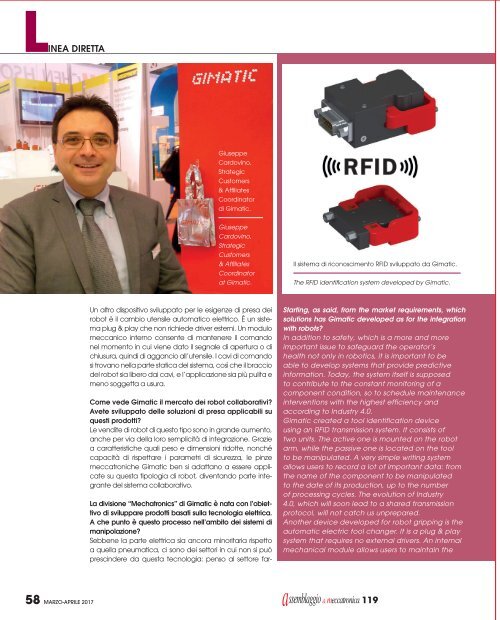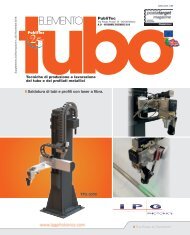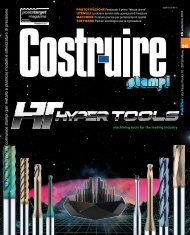ASSEMBLAGGIO_n119_MARZO_APRILE_2017
You also want an ePaper? Increase the reach of your titles
YUMPU automatically turns print PDFs into web optimized ePapers that Google loves.
LINEA DIRETTA<br />
Giuseppe<br />
Cardovino,<br />
Strategic<br />
Customers<br />
& Affiliates<br />
Coordinator<br />
di Gimatic.<br />
Giuseppe<br />
Cardovino,<br />
Strategic<br />
Customers<br />
& Affiliates<br />
Coordinator<br />
at Gimatic.<br />
Il sistema di riconoscimento RFID sviluppato da Gimatic.<br />
The RFID identification system developed by Gimatic.<br />
Un altro dispositivo sviluppato per le esigenze di presa dei<br />
robot è il cambio utensile automatico elettrico. È un sistema<br />
plug & play che non richiede driver esterni. Un modulo<br />
meccanico interno consente di mantenere il comando<br />
nel momento in cui viene dato il segnale di apertura o di<br />
chiusura, quindi di aggancio all’utensile. I cavi di comando<br />
si trovano nella parte statica del sistema, così che il braccio<br />
del robot sia libero dai cavi, e l’applicazione sia più pulita e<br />
meno soggetta a usura.<br />
Come vede Gimatic il mercato dei robot collaborativi?<br />
Avete sviluppato delle soluzioni di presa applicabili su<br />
questi prodotti?<br />
Le vendite di robot di questo tipo sono in grande aumento,<br />
anche per via della loro semplicità di integrazione. Grazie<br />
a caratteristiche quali peso e dimensioni ridotte, nonché<br />
capacità di rispettare i parametri di sicurezza, le pinze<br />
meccatroniche Gimatic ben si adattano a essere applicate<br />
su questa tipologia di robot, diventando parte integrante<br />
del sistema collaborativo.<br />
La divisione “Mechatronics” di Gimatic è nata con l’obiettivo<br />
di sviluppare prodotti basati sulla tecnologia elettrica.<br />
A che punto è questo processo nell’ambito dei sistemi di<br />
manipolazione?<br />
Sebbene la parte elettrica sia ancora minoritaria rispetto<br />
a quella pneumatica, ci sono dei settori in cui non si può<br />
prescindere da questa tecnologia: penso al settore far-<br />
Starting, as said, from the market requirements, which<br />
solutions has Gimatic developed as for the integration<br />
with robots?<br />
In addition to safety, which is a more and more<br />
important issue to safeguard the operator’s<br />
health not only in robotics, it is important to be<br />
able to develop systems that provide predictive<br />
information. Today, the system itself is supposed<br />
to contribute to the constant monitoring of a<br />
component condition, so to schedule maintenance<br />
interventions with the highest efficiency and<br />
accordingtoIndustry4.0.<br />
Gimatic created a tool identification device<br />
using an RFID transmission system. It consists of<br />
two units. The active one is mounted on the robot<br />
arm, while the passive one is located on the tool<br />
to be manipulated. A very simple writing system<br />
allows users to record a lot of important data: from<br />
the name of the component to be manipulated<br />
to the date of its production, up to the number<br />
of processing cycles. The evolution of Industry<br />
4.0, which will soon lead to a shared transmission<br />
protocol, will not catch us unprepared.<br />
Another device developed for robot gripping is the<br />
automatic electric tool changer. It is a plug & play<br />
system that requires no external drivers. An internal<br />
mechanical module allows users to maintain the<br />
58 <strong>MARZO</strong>-<strong>APRILE</strong> <strong>2017</strong> & meccatronica 119





